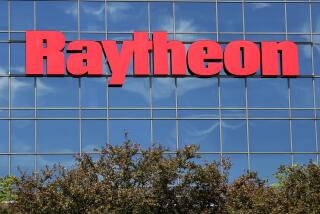U.S. Picks Up Legal Costs for Nuclear Firms
- Share via
When contractors at the giant Hanford atomic weapons site in Washington state were hit with class-action suits by workers and neighbors, they hired some of the best legal talent available, running up attorneys’ fees of $10.8 million last year alone.
Facing huge damage claims for toxic and radioactive pollution, the companies are responding without having to worry about the legal cost. The reason? Their defense is being funded by taxpayers--who will also pay for settlements or judgments if the contractors lose in court.
This policy of protecting the contractors dates back to the Manhattan Project and development of the atomic bomb. In order to enlist private firms in the effort, the Atomic Energy Commission promised to indemnify them against legal and financial risks. Officials said the hazards of weapons development were unknown and private industry would have refused to take part without the broadest liability protections.
As that policy has continued, though, the environmental cleanup and litigation costs have soared. And over the past two years, the U.S. Department of Energy, successor to the AEC, has paid more than $25 million in legal bills for private contractors at atomic weapons production sites, according to figures obtained by The Times.
In the biggest case, involving contractors at Hanford, the government is paying for the defense of six big corporations--Rockwell International, Westinghouse, Du Pont, General Electric, Atlantic Richfield and UNC Nuclear Industries--who have retained 10 law firms. Their bills were $10.8 million last year and are expected to come to an additional $28 million during the next two years.
The same thing is happening on a smaller scale at five other U.S. nuclear sites: the Rocky Flats plant in Colorado, the Oak Ridge reservation in Tennessee and the Mound, Fernald and Portsmouth plants in Ohio. The contractors manage the sites and perform production and research activities.
Critics have attacked the arrangement--asking, among other things, why the government should pick up every penny of legal costs--and why private lawyers who charge up to $300 per hour, not government attorneys, are handling the defense.
“I think it’s outrageous that the taxpayers are having to pick up the bill for private contractors’ mistakes and faults,” said Rep. Mike Synar (D-Okla.), chairman of the House Environment, Energy and Natural Resources subcommittee. “These law firms are making a fortune off the taxpayers for something the taxpayers shouldn’t have to pay for.”
Spokesmen for the contractors say the arrangement is proper.
“The government negotiated these contracts . . . and the government is contractually, morally and legally obligated to stand behind its commitment,” said an official with Rockwell International, a defendant at both Hanford and Rocky Flats.
(In pleading guilty last week to 10 criminal counts of environmental law violations at Rocky Flats, Rockwell accused the DOE of inhibiting its ability to comply with federal regulations. But there was no immediate word on whether Rockwell would seek government help in paying fines of $18.5 million.)
DOE officials also said the use of private law firms is dictated by the small size of the DOE’s litigation staff, and by the specialized experience the private firms possess.
“It’s pretty obvious that me, with my little office of 15 or 20 lawyers, could not handle” all the cases, said Marc Johnston, DOE’s deputy general counsel for litigation.
Some of the lawsuits have been brought by groups of people who claim they have suffered increased health risks--and in some cases cancer or other ailments--due to careless operation of the nuclear sites. Other suits seek damages for emotional distress and diminished property values allegedly caused by toxic and radioactive pollution. The contractors have denied the claims.
The DOE contractors have enjoyed a legal safety net that “is fairly unique” in government contracting, said Stuart B. Nibley, chairman of the government contracts practice at the law firm of Seyfarth, Shaw, Fairweather & Geraldson.
But critics say the policy has encouraged carelessness and contributed to serious pollution at DOE sites.
“One of the reasons we are seeing . . . massive claims being brought by citizens and workers all over the country is because there has been no accountability on the part of contractors,” said Dan Reicher, a staff attorney with the Natural Resources Defense Council, an environmental group.
“Now we’re paying the price, both in terms of possible impacts on human health and the environment, and potential major assaults on the federal treasury,” Reicher said.
“The argument is always made that you wouldn’t have gotten companies to agree to take on these responsibilities,” Reicher added. But he said “there was a middle ground somewhere that we never found.”
DOE officials admitted as much last year when they adopted a rule to make contractors more accountable for safety and environmental lapses. The new rule, the agency said, will hold contractors responsible “for costs that could have been avoided by proper contractor performance.”
However, the regulation only covers new contracts and future conduct. That’s why the government still pays contractors’ legal bills--and even environmental fines.
In January, for example, Martin Marietta Energy Systems agreed to pay a $50,000 settlement to the Environmental Protection Agency for alleged PCB violations at Oak Ridge and two other DOE sites run by the company. However, the DOE will reimburse the money, according to officials with the agency and Martin Marietta.
Similarly, when contractors at DOE’s uranium refining plant in Fernald, Ohio, settled environmental complaints by the state of Ohio, the DOE paid for it: $60,000 for Westinghouse, the plant operator, and $275,000 for National Lead of Ohio, the former operator.
DOE also paid the tab in 1989 when Rockwell International, former operator of Rocky Flats, settled a hazardous waste complaint with the state of Colorado for $95,800.
The DOE will probably reimburse $50,000 of the $280,000 Rockwell recently paid the state of California to settle a hazardous waste case, a DOE spokesman said. The settlement, reached in November, 1990, involved Rockwell operations in Canoga Park and at the Santa Susana Field Laboratory west of Chatsworth. Rockwell does research for DOE at Santa Susana, and the spokesman said the payment would cover alleged violations linked to that work.
Such fines are small change beside the claims of workers and neighbors in the class action suits.
This wave of litigation began with a suit against National Lead by neighbors of the Fernald plant near Cincinnati. Since it is difficult, under several legal doctrines, to win damages directly from DOE, the plaintiffs adopted the strategy of suing only National Lead. DOE attorneys took over the company’s defense as allowed under the contract.
After a mock trial produced a jury verdict against National Lead, DOE in 1989 paid a $73-million settlement to cover property loss, emotional distress and medical monitoring of plant neighbors.
Buoyed by that success, plaintiff lawyers in 1990 filed similar claims against contractors at Hanford, Rocky Flats and the Portsmouth uranium enrichment plant. Another class action against National Lead was also filed in 1990, this time by Fernald workers. And similar claims were filed last fall against contractors at Oak Ridge and the Mound plant in Miamisburg, Ohio.
Johnston, the DOE’s litigation chief, said DOE lawyers review the work of the private lawyers as well as their bills--and kick out unacceptable charges like first-class air travel and wine with dinner. “We are particularly watchful for things that look, quote, out of line,” said James Foutch, assistant chief counsel for the DOE field office at Oak Ridge.
But critics question the degree of oversight, arguing that contractors and their attorneys have little incentive to control costs.
“It just seems like everybody’s in the trough and has got their nose up in it,” complained Federico Castelan Sayre, a plaintiffs’ attorney in the Hanford litigation, the largest and most costly of the cases.
The Hanford litigation is a group of five class actions filed on behalf of property owners, Native Americans and workers who claim to have suffered a variety of harms from toxic and radioactive releases.
Rather than conducting a joint defense, the six contractor-defendants have each retained separate counsel, including such well-known firms as Gibson, Dunn & Crutcher of Los Angeles; Kirkland & Ellis of Chicago, and Crowell & Moring of Washington, D.C. Four defendants--Rockwell, General Electric, Du Pont and UNC Nuclear--have hired two law firms each.
More to Read
Sign up for Essential California
The most important California stories and recommendations in your inbox every morning.
You may occasionally receive promotional content from the Los Angeles Times.













